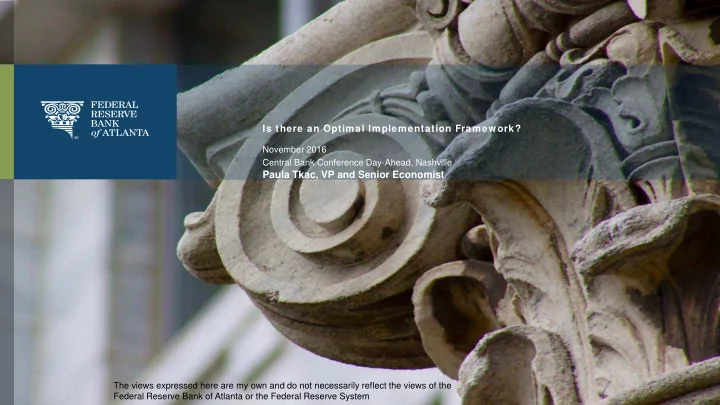

Is there an Optimal Implementation Framework? November 2016 Central Bank Conference Day-Ahead, Nashville Paula Tkac, VP and Senior Economist The views expressed here are my own and do not necessarily reflect the views of the Federal Reserve Bank of Atlanta or the Federal Reserve System Proprietary and Confidential. Not for disclosure outside Federal Reserve.
Components of a Monetary Policy Implementation Framew ork • Balance Sheet – active policies and financial stability • Policy Rate/Target Rate – unsecured v. secured • Operating Regime – flat v. steep portion of the reserve demand curve • Liquidity provision – separation from or integration into operating regime Subject to Normalization Principles (Sept. 2014) • Holding no more securities than necessary to implement monetary policy efficiently and effectively. • The assets held by the FRS will consist mainly of US Treasury Securities. Proprietary and Confidential. Not for disclosure outside Federal Reserve.
Assessing the Options Framework Objectives I. Achieving appropriate control over short-term interest rates including during periods of financial distress and in a manner robust to structural changes in the financial system. II. Enhancing the ability of the FRS to achieve macroeconomic and financial stability objectives at the zero bound. III. Supporting the System’s ability to address liquidity strains in money markets and support overall financial stability. IV. Reduce burdens and deadweight losses associated with reserve requirements. V. Promote efficient, active and resilient money markets and government securities markets. VI. Promote and efficient and resilient payment system. Proprietary and Confidential. Not for disclosure outside Federal Reserve.
Assessing Alternative Policy Rates Choices and Criteria Choices • Market Rates – Unsecured: Fed Funds Rate and Overnight Bank Funding Rate – Secured: GC Treasury Repo Rate • Administered Rates – Interest on Reserves – ON RRP offering rate Criteria Controllability Transmission Robustness Clarity Proprietary and Confidential. Not for disclosure outside Federal Reserve.
Is there an Optimal Policy Rate Choice? No • Staff are confident control can be achieved with either unsecured or secured rates • US money market rates are highly correlated + Foreign experience suggests transmission is good with market or administered rates • Changes in business models and regulations may change patterns of interconnectedness – GLIR – Administered Rates • Clarity of communication involves intentions and response functions Proprietary and Confidential. Not for disclosure outside Federal Reserve.
Components of an Operating Regime • Ceiling – standing lending facility • Floor – deposit facility or interest on reserves • Discretionary open market operations – move the supply curve • Level of reserves and use of voluntary or mandatory reserve targets – shape the demand curve for reserves Proprietary and Confidential. Not for disclosure outside Federal Reserve.
Operating Regime – Case 1 (Current) • Floor tools would be particularly important Assessment: • Ceiling tools could be useful to contain rate volatility Sufficient Control Liquidity easy since • Reserve requirements would be unnecessary reserves unrelated to rate control • What is the appropriate level of reserves? Can eliminate DW loss of reserve requirements Details: Supports active FFR or OBFR? money markets Supports early Political economy concerns with IOER/ON RRP spread payment settlement 7 Proprietary and Confidential. Not for disclosure outside Federal Reserve.
Operating Regime – Case 2 (pre-Crisis) • Key tool is reserve requirements, either mandatory or voluntary Assessment • Discretionary OMOs would play an important role in offsetting Sufficient control with OMO volatile autonomous factors Tools needed to • Ceiling and floor tools help limit the volatility of interest rates sterilize liquidity or transition to Case 1 VRT reduces DWL Details: Support money FF market would likely return but could disappear again at ZLB market activity Support payment DIRF and FIRF as ceiling tools activity with VRT Could eliminate need for ON RRP 8 Proprietary and Confidential. Not for disclosure outside Federal Reserve.
Operating Regime – Case 3 (repo) • Key tools are ceiling and floor: ON RP and ON RRP Assessment: facilities Can target successfully but may • Level of reserve balances may impact unsecured rates require large/frequent volatility ops Ample provision of • Reserve requirements and discretionary OMOs may not be liquidity with ON RRP necessary Can eliminate DWL Supports money • Counterparties and parameter settings of the facilities could market activity broadly affect interest rate control Supports payment system efficiency 9 Proprietary and Confidential. Not for disclosure outside Federal Reserve.
Overall Assessment Comparing Cases 1-3 • All likely achieve rate control – Case 2 requires OMO and FF market comes back – Cases 1 and 3, FF market vulnerable • Providing liquidity is easy in Case 1 and Case 3 (if large reserves) – Case 2 requires sterilization, as does Case 3 if scarce reserves – Transition to ZLB/flat portion would require restart of RRP facility if decommissioned • Cases 1 and 3 can operate w/o reserve requirements, Case 2 would use VRT • All cases support money markets • All frameworks have sufficient reserves to support payment efficiency Proprietary and Confidential. Not for disclosure outside Federal Reserve.
Other Factors • Governance: BoG has authority over IOER, FOMC over ON RRP • Political economy considerations: counterparties and interest on reserves • Are expanded counterparties needed? Frictions may be high in times of stress • Liquidity provision tools: – Full integration – Conditional – Inactive – Counterparties and Collateral: moral hazard and liquidity transformation Proprietary and Confidential. Not for disclosure outside Federal Reserve.
Recommend
More recommend